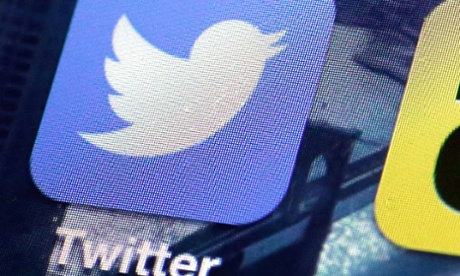
With only 140 characters, it can be hard to tell the right story on Twitter. In its short life as a public company, the social media company itself has had its own struggles with messaging – struggles that will be in sharp focus on Tuesday when it talks to Wall Street about its latest quarterly results.
Twitter may seem ubiquitous – a word chief executive Dick Costolo likes to throw around when describing the social media firm’s influence, especially around events like the World Cup. But no matter how often the media calls for people to follow them on Twitter, fewer people seem to be listening and, in the US in particular, growth has slowed to a trickle.
The number Wall Street is focused on is monthly active users (MAUs) – the number of people who logged into Twitter during the month. In the first quarter of 2014 Twitter, reported it had 255m MAUs, up 25% year-over-year but up only 6% from 241m in the prior quarter. Twitter’s stock priced slumped on the news, and the company has since undergone a major management reshuffle. Analysts are expecting MAUs to slow again on Tuesday. What happens then?
Sterne Agee’s Arvind Bhatia and Brett Strauser are estimating MAUs for the second quarter of 266m, up just 4% from the prior quarter. Wunderlich Securities analyst Blake Harper estimates MAUs will be lower still, at between 260m and 262m.
Twitter cannot comment ahead of its quarterly earning report. There are hopeful signs that the World Cup was a boon for social media. Facebook recorded over 1bn interactions (post, likes, comments) during the tournament. And Twitter has said there were 672m Tweets sent related to the 2014 #WorldCup – which fell half in this quarter and half in the next.
But even if soccer saved the quarter for Twitter, the longer-term problem of the “Twitter quitter” remains. Last year a Reuters/Ipsos poll last year found 36% of people who joined Twitter say they do not use it. In comparison, only 7% of Facebook members reported not using it. For all Twitter’s attempts to add more photos, videos and easier ways to follow people, the world of RTs, MTs, hashtags and subtweets appears to be too much for many people.
In a note to investors, Harper said he expected positive news about “engagement” – how long people spend on Twitter – and “monetization”, or how much Twitter is making. However, he said: “Expectations are still too aggressive on MAU growth and the company has struggled to meaningfully grow its user base.”
The company clearly recognises that it has a problem. In June Ali Rowghani, Twitter’s chief operating officer, resigned after a dispute with Costolo. Rowghani, once Costolo’s closest ally and a man often described as Twitter’s Mr Fix-It, had taken over product development at Twitter last October when it became clear that company would badly miss its internal projection of 400m MAUs by the end of 2013.
At the start of the month, Twitter named Goldman Sachs banker Anthony Noto as its new chief financial officer. As a former top-ranked internet analyst, Noto is ideally positioned to start rewriting Twitter’s message to the analyst community.
BTIG analyst Richard Greenfield wrote in a recent blogpost that the World Cup had revealed some of Twitter’s strategy for attracting, and keeping, more users. Twitter sent out a World Cup-focused email before the tournament that showed people how to personalise the service so they could better follow news about their team.
“This is exactly what Twitter needs to do – leverage major events where live, real-time information and conversation are used to educate and engage consumers in the power and value of Twitter,” he wrote. He had some criticisms too – the lists provided were “extremely repetitive” and “seemingly odd or overly-generic choices”. They also failed to offer suggestions outside the World Cup that might have kept people engaged once the tournament ended, wrote Greenfield.
“Twitter is clearly showing a clear use case for the service via the World Cup email marketing campaign. The question remains: once the World Cup ends, will these reengaged users stick or be a one-time boost to Q2 MAUs?” he wrote.
Brian Weiser, senior research analyst at Pivotal Research Group, believes there was a more fundamental problem with Twitter’s message. He argues the company, as much as Wall Street, is guilty of focussing on the growing its user base when in fact it now looks like Twitter is a niche company – with its own unique audience and attractions.
“Maybe they haven’t accomplished what they set out to do but they have done some wonderful things,” he said. The company’s live, as it happens, nature, its mobile ad systems, and its ability to target key demographics offer advertisers something that other social media companies do not have, he said.
How does Twitter get Wall Street to look at something other than MAUs? It’s not going to be easy, said Weiser. Having Noto may help, but Twitter is going to need more than that to turn the debate. “There’s going to have be a little bit of ‘these aren’t the droids you’re looking for,’” he said.
It remains to be seen whether Costolo or Noto have the Jedi skills to pull that off.

